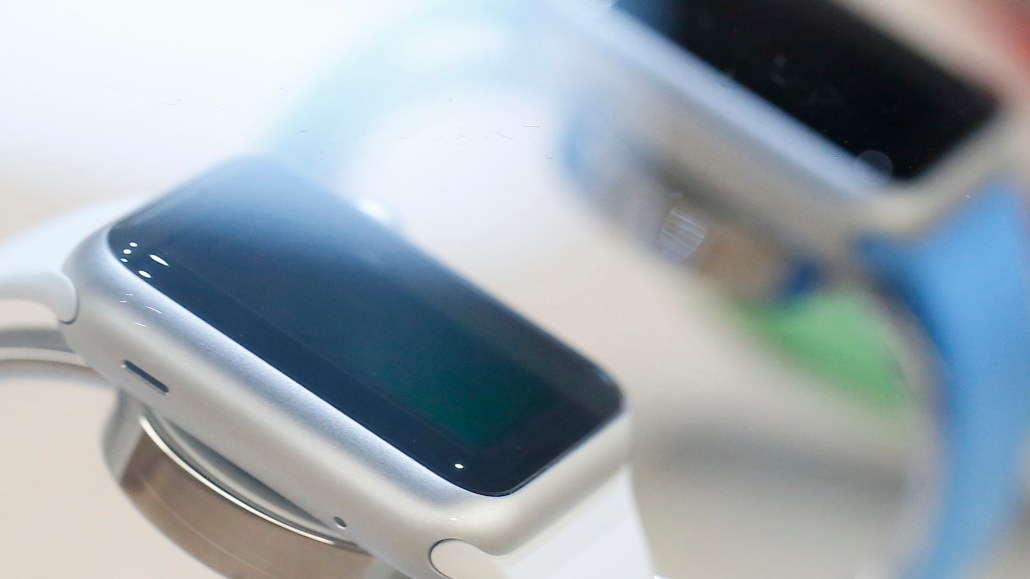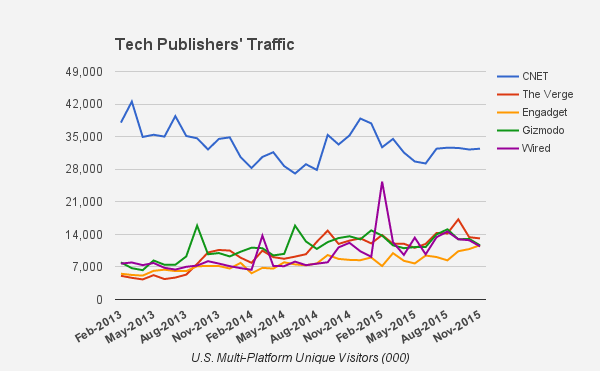
The tech news market is packed to the gills with sites covering the same topics in largely similar ways. That’s never more clear than during CES, when tech reporters and bloggers flood Las Vegas to cover the latest developments in consumer technology. Here’s how the biggest names in tech news stack up when it comes to traffic, video views, demographics and social reach.
CNET dominates when comes to traffic

CNET may not be as buzzy as its successors, but at age 21, it has a far larger audience. The site got 32 million unique visitors in November, three times the traffic from The Verge, Engadget and Wired. All, however, are virtually flat year-on-year.
CNET also has the biggest video audience
CNET has a big audience for its product-review-focused videos, whose viewership dominates its competitors. It’s followed by The Verge, which has increased its focus on social video this past year.
Ad position: web_incontent_pos1
The Huffington Post has the most Facebook shares; Twitter goes TechCrunch
When it comes to tech coverage, some of the most popular stories don’t come from pure play tech sites. Newswhip pulled data on the most popular sites on Facebook when it comes to tech news. No. 1 was The Huffington Post, whose tech stories were shared 1.1 million times from October to today, according to Newswhip, helped by its enormous digital footprint. It’s followed by The Verge, The Guardian and Wired. The tech sites fare better on Twitter, where TechCrunch, Engadget, Mashable and The Verge lead in shares.
CPMs
When it comes to CPMs, The Verge is on the high end. The site is charging a $55 CPM for its pre-roll and $24 to $27 for its banners, according to one agency exec. Wired wants $25 for its banners (and $39 for its pre-roll spots), while Gizmodo is asking for $12 for display and $25 for its 15-second pre-roll. CNET’s video ads come with a $42 price tag.
Mashable and Wired have the most gender balance
Ad position: web_incontent_pos2
When it comes to demographics, tech sites tend to skew young and male. Some have evened out the balance, though. Women make up 44.7 percent of Wired’s audience, according to comScore. It’s even higher at Mashable, which has a 54.7 percent female audience (and like the HuffPo, has a broad editorial mandate). The other sites hover around 33 percent female, though The Verge has been able to attract a more female readership by hiring more female reporters and writing product reviews from a female point of view.
Wired has the wealthiest readers

When it comes to comes to household income, there’s little variance among the big tech sites. Wired, though, has the highest percentage of readers with a household income above $100,000, followed by The Verge and CNET.
More in Media

NewFronts Briefing: Samsung, Condé Nast, Roku focus presentations on new ad formats and category-specific inventory
Day two of IAB’s NewFronts featured presentations from Samsung, Condé Nast and Roku, highlighting new partnerships, ad formats and inventory, as well as new AI capabilities.

The Athletic to raise ad prices as it paces to hit 3 million newsletter subscribers
The New York Times’ sports site The Athletic is about to hit 3 million total newsletter subscribers. It plans to raise ad prices as as a result of this nearly 20% year over year increase.

NewFronts Briefing: Google, Vizio and news publishers pitch marketers with new ad offerings and range of content categories
Day one of the 2024 IAB NewFronts featured presentations from Google and Vizio, as well as a spotlight on news publishers.
Ad position: web_bfu


